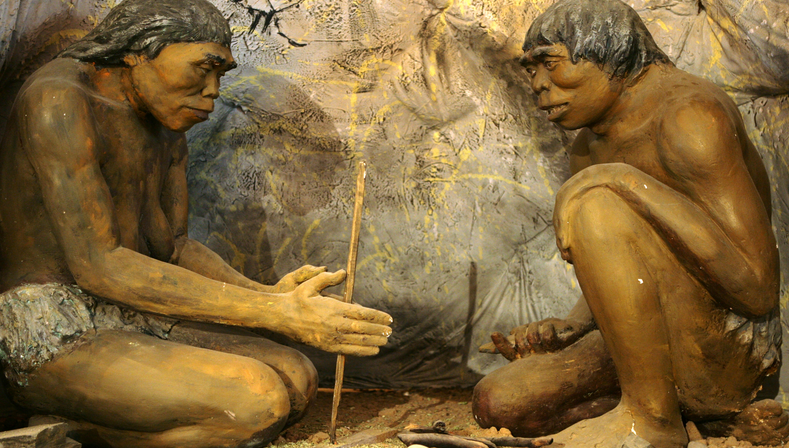(单词翻译:单击)
听力文本
Eating habits and food processing skills from around two million years ago helped humans to evolve and develop language. Researchers from Harvard University say that learning to cut meat up and using basic stone tools to process food was a crucial step in our evolutionary process. The fact that we cut food up or pounded and crushed it meant we needed less time for chewing. This gave our mouths more free time to develop language and communicate. The researchers estimate that cutting up meat and other food saved early humans as many as 2.5 million chews per year. In contrast, the chimpanzee spends half of its day chewing, which means it has less time to communicate.

The researchers also said the shape of our face changed because we needed to chew less. Our jaws and teeth became smaller because we had learnt to cut up food. Professor Daniel Lieberman said: "We went from having snouts and big teeth and large chewing muscles to having smaller teeth, smaller chewing muscles, and snoutless faces. Those changes, and others, allowed for the selection for speech and other shifts in the head, like bigger brains." Dr Lieberman chewed raw goat meat to test his theory. He said: "You chew and you chew and you chew and you chew, and nothing happens." He added that to some extent, slicing meat into smaller pieces before chewing, "is the simplest technology of all".
中文翻译
约200万年前,人类饮食习惯和食品加工技术促进语言发展。来自哈佛大学研究人员表示,在食品加工过程中,切割与基本石器技术是人类进化的重要一步。通过切割,锤击或砸击食物,人类缩短了咀嚼时间。并为语言发展,沟通交流留有更多时间。据研究人员预测,通过切割食物,每年节省咀嚼次数多达2500万次。但对于黑猩猩来说,每天一半时间用来咀嚼,沟通时间大大减少。
据研究人员所述,由于咀嚼次数减少,人类脸型开始发生变化。由于切割术,下巴和牙齿体积变小。据丹尼尔·利伯曼所说:“从宽鼻大嘴到小鼻小嘴,从咀嚼肌发达到咀嚼肌薄弱。这些变化为沟通赢得空间,大脑等脑部活动也发生变化。”利伯曼通过咀嚼生山羊肉来验证理论。他认为:“在这一过程中,除了咀嚼还是咀嚼。”他还称在某种程度上,切割技术最为简单。”
译文属可可原创,仅供学习交流使用,未经许可请勿转载
重点讲解
1.cut up 割碎
例句:She cut up the carrots and put them in the pot.
她把胡萝卜切碎放入锅中。
2.learn to 学习
例句:Or learn to love it, like me?
或者学着像我一样喜欢它?
3.in contrast 相反
例句:It was cold yesterday, but in contrast it's very hot today.
昨天天气寒冷, 而相比之下今天却很热。
4.to some extent 在某种程度上
例句:So to some extent I'm for it.
所以在一定程度上,我支持它!
听力题目
1.What did eating habits help to develop two million years ago?
a) table manners
b) cutlery
c) language
d) roasted meat
2.Which university conducted the research?
a) Harvard
b) Sorbonne
c) Oxford
d) Tokyo
3.What did we need to do less because we cut meat up?
a) hunt
b) cook
c) speak
d) chew
4.How many chews per year did cutting up meat save early humans?
a) 25,000,000
b) 2,500,000
c) 250,000
d) 250,000,000
5.How much of the day does a chimpanzee spend chewing?
a) a fifth
b) two-thirds
c) half
d) three-quarters
6.What did the need to chew less change the shape of?
a) dinner tables
b) our face
c) shops
d) knives
7.What became smaller because of the need to chew less?
a) our tongue
b) knives
c) saucepans
d) our teeth
8.What part of our bodies became bigger?
a) our hands
b) our brain
c) our jaw
d) our tongue
9.What kind of meat did a researcher chew to test his theory?
a) goat
b) camel
c) chicken
d) horse
10.What did the researcher say was the simplest technology of all?
a) chewing
b) cooking food
c) talking
d) slicing meat
听力答案
1.c
2.a
3.d
4.b
5.c
6.d
7.b
8.d
9.a
10.d


